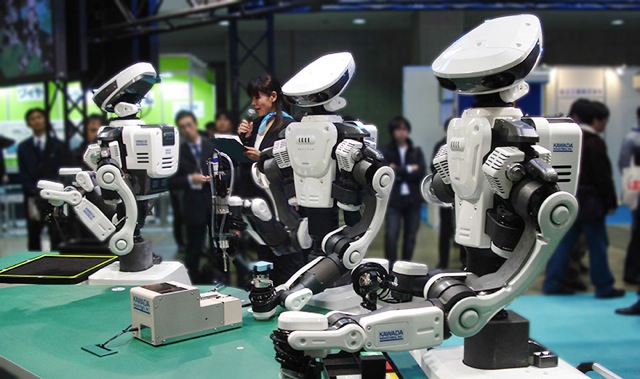
Japanese companies prepare to bring forward new generation of humanoid collaborative robots capable of a variety of industrial work
There was a time when Japanese electronics companies were the Apples and Googles of the world, with everyone buying their products and talking about them in the media.
Many of those same formerly pre-eminent names today play second fiddle to the Silicon Valley tech giants.
But while they may not be discussed as much as they were in the past – and their products not as ubiquitous in the consumer market – Japanese companies still loom large in the industrial sector.
Hitachi, one of those Japanese companies whose branding was all over the place in the past, last year generated revenues of approximately $80 billion.
It’s difficult to describe Hitachi in simple terms because its activities are so diverse, but the word conglomerate is generally used for such companies.
Hitachi’s many business activities and units include industrial machinery, telecommunications equipment, construction equipment, automotive components, and of course electronics.
It still makes consumer products such as television sets, as well as power tools and computing devices – mainly servers and data storage systems.
It also makes bullet trains and power stations.
And lately, in the past few years, Hitachi has been getting more involved in robotics.
Although it puts a small humanoid robot front and centre of the robotics section of its website, behind the scenes Hitachi has been partnering with other Japanese companies to develop robots for industry.
Working with Seiko Epson, which is supplying the hardware, Hitachi is developing the software systems for an industrial robot with two arms.
Pictured below, the robot’s planned application is in warehouses – for picking, placing and packing.

Hitachi has previously said it does not plan to sell the warehouse robot to other companies initially.
As quoted in the Japan Times a couple years ago when the warehouse robot was first unveiled, Toshio Moriya, a general manager at Hitachi’s technology innovation center, said: “We plan to start using them in our own group companies in two to three years and selling them in around five years.”
A few years on, the company looks as if it’s preparing to offer the robot to the market – if it’s activities relating to some of its other robots is anything to go by.
As well as Epson, Hitachi has been working with Kawada Industries on another dual-armed industrial robot.
Kawada, which mainly builds bridges and other large structures, established its Kawada Robotics business unit about four years ago, mainly as a result of a robot the company started developing almost 20 years ago.
The robot provided Kawada the platform to develop a number of variations, and one of the latest iterations is called NextAge (main picture), which may become the first dual-armed humanoid to be widely used in the industrial sector.
NextAge is now featured on Hitachi’s website and may be a prelude to the launch of the Hitachi-Epson robot, which is of a more conventional design, using Epson ProSix robot arms and no humanoid features.
So far, the industrial sector has almost exclusively selected the single-arm industrial robot most people will be familiar with, and only in the past year has ABB’s dual-armed robot, YuMi, been finding some space at factories here and there.
Rethink’s two-armed Baxter robot is also making an impression.
But there’s not many humanoid robots in industry at the moment, Baxter’s illustrated face on the screen notwithstanding.
Hitachi technologists say the dual-armed NextAge and other robots of that design could do any type of work in any industry – within reason.
They are versatile enough to work in either the automotive industry or electronics – both of which are the biggest buyers of industrial robots.
And, as one might expect, they are safe for humans to work alongside, which makes them collaborative robots.
The traditional, large industrial robotic arms which need to be caged off will almost certainly continue to be used for a long time, if only because they are capable of heavy payloads and workloads that the smaller collaborative robots are not designed for.
But this does look like the beginning of a sea-change in industrial robotics and automation systems.
Hitachi has also developed a small humanoid robot, Emiew, although this one is totally unsuitable for heavy industrial work – not sure if it’s capable of any work at all really.
More about Emiew (pictured below) in a future article.



